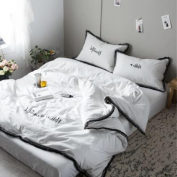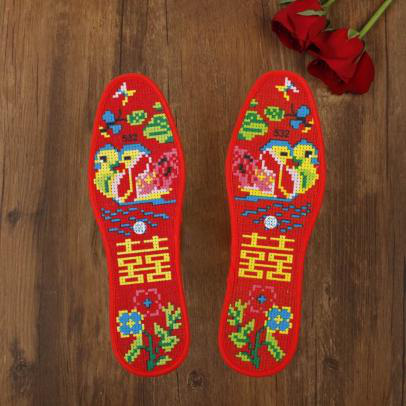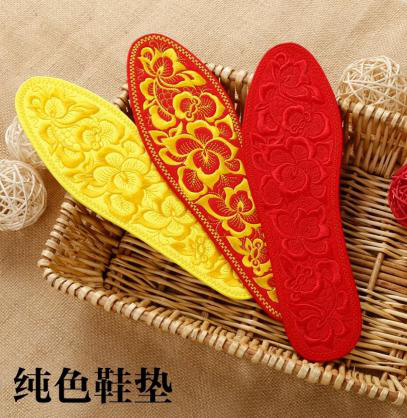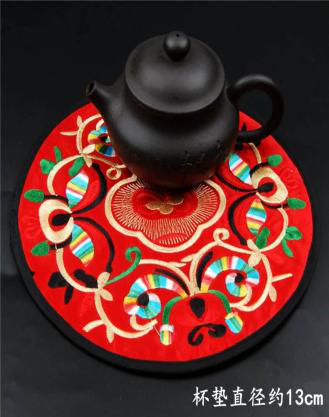Can our masks prevent bacteria and PM2.5?
From January 11th to 14th, the smog enveloped the entire North China region, causing PM2.5 to explode, and heavy pollution hit most parts of northern China. The relevant departments remind the public to try not to go out. However, a large number of students and office workers have to rush into the sea of ​​fog. According to a spokesperson of the Ministry of Health on January 10, the H1N1 influenza virus (referred to as the A stream) has become a seasonal flu in northern China. In the face of serious air and virus pollution, the public can only choose to wear a mask. But can a small mask help us stay away from dust and bacteria? Embroidery daily necessities
Almost everyone in the modern pursuit of quality of life, especially those urban families, for the most basic household products are very aware of the brand, especially personal daily necessities. With the emergence and development of embroidery products, and in view of people's health awareness of silk and their own health, embroidery has become the new darling of the market, widely loved by everyone. Aisha•Lee Hui embroidery development so far, the scale has been formed, the product category more, including daily necessities are also distinctive, rich in variety, drawn mostly birds and insects fish, folk and traditional ornamentation, quite festive color. We have a professional design team dedicated to creating different products, using the modern perspective, aesthetic view of traditional culture, and with the market-oriented model, to promote and derive.
Aisha•Lee embroidery products out of respect for the traditional process, our products are after numerous folk artists perception of the natural environment, the result of the idea. Each of our products is an affectionate piece of embroidery embroidered by countless needles.
Hand Embroidery Of Daily Necessities Hand Embroidery Of Daily Necessities,Embroidery Of Daily,Embroiderd Hanging Paintings,Hanging Paintings Embroidery Haiyuan Aisha Handicrafts Company Limted , https://www.nxembroidery.com
Two fines: bacteria, fine particles There are two major types of substances in the air that cause damage to human health. First, various fine particles include soot, total suspended particulate matter, respirable suspended particulate matter, and nitrogen dioxide, sulfur dioxide, carbon monoxide, ozone, Volatile organic compounds, etc. The second is various types of bacteria and viruses. In the urban air quality report, inhalable particulate matter and total suspended particulate matter are two familiar atmospheric pollutants, PM10 and PM100, which are particles and diameters that can enter the human respiratory system with a diameter greater than 2.5 microns and equal to or less than 10 microns. Particulate matter less than or equal to 100 microns. Due to the small particle size of the fly ash, these particles can be directly inhaled into the respiratory tract by the human body, causing damage to the respiratory system and seriously affecting the health of the body.
In February 2012, the State Council agreed to issue a new revised Ambient Air Quality Standard to increase PM2.5 monitoring indicators. PM2.5 refers to particulate matter in the atmosphere that is less than or equal to 2.5 microns in diameter, also known as inhalable particulate matter. The diameter is equivalent to 1/10 of the size of human hair and is not easily blocked. The hazard is that it enters the bronchi directly after being inhaled, interferes with the gas exchange in the lungs, and causes diseases such as asthma, bronchitis and cardiovascular diseases. PM2.5, which has a small particle size and is rich in toxic and harmful substances and has a long residence time in the atmosphere and a long transport distance, has a great influence on human health.
Among the bacterial viruses, bacterial viruses represented by H1N1 (influenza A H1N1 subtype virus), H5N1 (a subtype of avian influenza), and MRSA (methicillin-resistant Staphylococcus aureus) are harmful to human health. A big culprits.
Masks are generally classified into two types: air filter masks and air supply masks. The air supply type mask refers to a clean air source that is isolated from harmful substances, and is sent to a person's face through a tube and a mask through a power action such as a pressure machine or a compressed gas cylinder device for breathing.
At present, most of the masks on the market are air filter masks. The performance of the mask varies depending on the filter material.
Surgical mask: Made of three layers of non-woven fabric, suitable for use in the operating room environment; can block particles with a diameter of about 4 microns or more.
Activated carbon mask: Adding activated carbon material, the main function is to separate the taste, but the respiratory resistance will increase. At the same time, activated carbon itself is also a source of particulate matter, which is likely to be inhaled by the wearer. It may cause a hazard to people with chronic respiratory diseases or infirmity.
Dust mask: It is mainly dustproof and useful for blocking large particles. However, for particles with a diameter of less than 5 microns, the barrier effect is limited and the antibacterial function is general.
PM2.5 mask: Effectively resists the intrusion of PM2.5 particles, effectively blocking bacteria and particles below 0.3UM in the air. However, at present, the PM2.5 protective mask market is mixed, and the masks with the "PM2.5" banner can be seen everywhere, and there are various models such as anti-particle type, anti-formaldehyde type and activated carbon type, which can not only protect PM2.5, but also breathable. Sex is also poor, chemical fiber fabrics will also stimulate the bronchial, skin allergies, nose discomfort and other symptoms.
In addition, there are many multi-function masks such as sunshade masks, UV masks, cartoon masks and riding masks.
According to Sun Ximin, head of the Standards Division of the China National Textile and Apparel Council, there is no standard for daily protective masks in China. Only medical mask standards, such as the technical requirements for medical surgical masks of YY0469-2004.
In order to fill the blank of China's standard in the field of daily masks, Shanghai Xingnuo Kanglun Fiber Technology Co., Ltd., the vice chairman unit of the National Health Industry Management Association Antibacterial Branch, has developed the "Antibacterial and Anti-mite Daily Mask" and "Antibacterial Defense". The two standards for non-woven masks for daily use have been approved by the quality supervision department.
Foreign countries also have their own mask standards, such as the European Union EN149 standard, the National Institute of Occupational Safety and Health (NIOSH) dust-based respiratory protection new standards, Australia AS1716 standard, Japan MOL verification standards.
The NIOSH standard divides the filter media into three types: N series: it can be used to protect non-oily suspended particles; R series: can be used to protect non-oily and oily suspended particles; P series: can be used to protect non-oily and oily suspended particles.
In terms of the minimum filtration efficiency of the filter material, there are three grades: 95 grade means minimum filtration efficiency ≥ 95%; 99 grade means minimum filtration efficiency ≥ 99%; and 100 grade means minimum filtration efficiency ≥ 99.97%. Therefore, N95, R95, P95 and N99, R99, P99, and even N100, R100 and P100 masks with higher filter function can effectively filter suspended particles or germs.
Masks choose how to buy masks from the prevention of "two fine"? According to Zhang Yingzeng, director of the Secretariat of the National Health Industry Management Association, the mask material, technical level, and service life are the criteria for defining the quality of the mask. Consumers should choose carefully and use mask products that have been verified by authoritative testing agencies.
At present, Shanghai Xingnuo Kanglun Fiber Technology Co., Ltd. has launched a “Green Shield†mask that can isolate submicron particles (including PM2.5 particles) and resist the three super bacteria H1N1, H5N1 and MRSA.
According to Zhao Danqing, the company's chairman, the Green Shield PM2.5 mask uses two patented technologies: microfiltration and Kanglun antibacterial technology, which can effectively resist bacteria and fine particles. The Green Shield PM2.5 mask is placed in the middle layer with a microfiltration filter. The microfiltration filter is tested by the NELSON laboratory in the United States, which can effectively filter PM2.5 air particles, and the filtration effect is as high as 99%. The fabric of the mask adopts the only comben fabric in the world which can effectively resist the three “super bacteria†at the same time. The fabrics passed the H1N1 virus in the US Micorbac laboratory in February 2011, and passed the anti-super in Switzerland SGS laboratory in October. The MRSA test was carried out in November by the American BioScience Laboratory for anti-NDM-1 "super bacteria" test. In April 2012, it passed the Japanese SEK medical highest (red) level antibacterial test. The Green Shield PM2.5 mask developed by these two technologies has become the first special mask in China to effectively prevent PM2.5 particles and resist bacteria.
The National Labor Protection Products Quality Supervision and Inspection Center test report shows that the Green Shield PM2.5 mask breathable effect is far better than the national standard. The appearance of the green shield mask adopts a three-dimensional design, which is consistent with the physiological composition of the human body, and solves the use restriction of the conventional mask and the anti-virus mask N95, such as difficulty in breathing, hypoxia and dizziness.
Mask History â— The first mask in the world is China. At the beginning of the 13th century, masks appeared in Chinese courts. In order to prevent the breath from being transmitted to the emperor's food, the waiter used a scarf made of silk and gold thread to make a mask.
â— At the end of the 19th century, masks began to be used in the field of health care. German pathologist Ledridge began to recommend that medical staff use gauze masks to prevent bacterial infections.
â— At the beginning of the 20th century, masks became the must-have for the first time. The Spanish flu, which swept the world, claimed the lives of about 50 million people. The general population was asked to use masks to fight the virus.
â— In the middle and late 20th century, the number of large-scale use of masks was significantly frequent. Masks in the past flu have been playing an important role in preventing and blocking the spread of germs.
â— Later, someone made a mask of six layers of gauze, sewn on the collar. Turn over and cover your nose and mouth when you use it. However, such a mask has to be held by hand, which is extremely inconvenient. Later, someone thought of using a strap on the ear, which became the mask that people often use today.
â— In 2003, China was infected with atypical pneumonia, which almost caused the masks to be out of stock. There were long queues in front of major pharmacies, and people rushed to buy masks.
â— In 2009, following the "bird flu" in 2004, the "H1N1 flu" made the mask army appear again in front of the camera and reports of the world's major news media.
Embroidery is one of China's outstanding national traditional crafts. China was the earliest country in the world to find and use silk, and people started reeling and reeling four or five thousand years ago. With the use of silk, silk production and development, embroidery process is also gradually emerging, and involves all aspects of human life.




